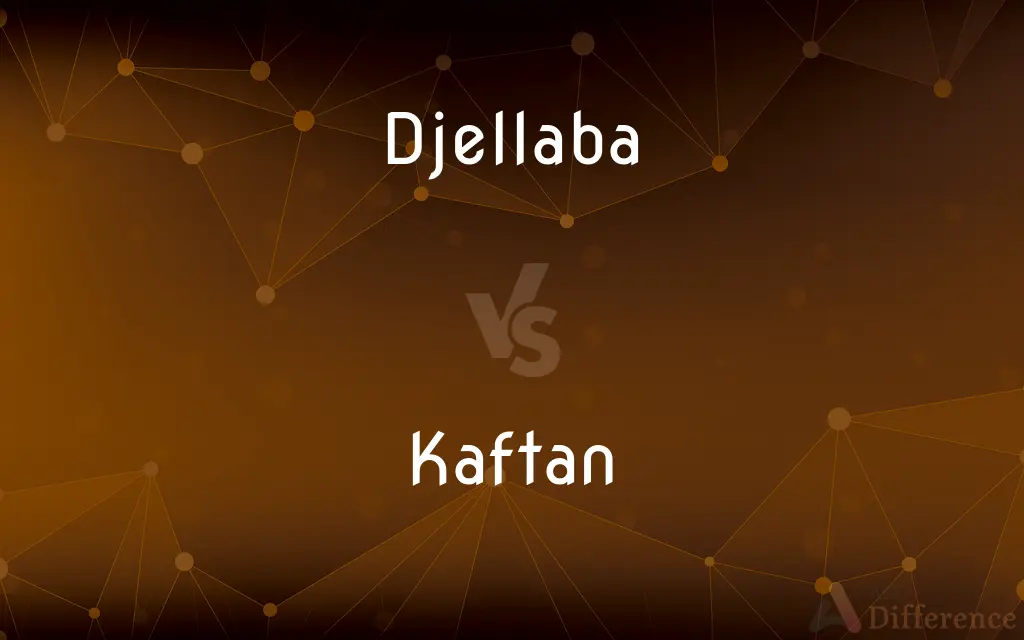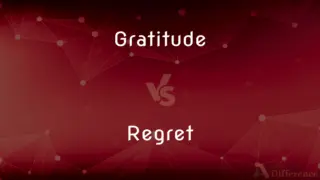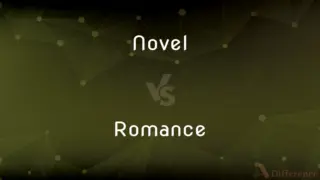Djellaba vs. Kaftan — What's the Difference?
Edited by Tayyaba Rehman — By Fiza Rafique — Updated on April 19, 2024
Djellaba features a pointed hood and is worn in North African cultures, typically snugger and longer, while a kaftan, common in the Middle East, is open, wider, and often more ornate.

Difference Between Djellaba and Kaftan
Table of Contents
ADVERTISEMENT
Key Differences
Djellaba is traditionally worn in North African countries like Morocco and Algeria, characterized by its long, loose fit and pointed hood, known as a "qob." This design is suitable for the desert climate, offering protection from the sun and sand. On the other hand, the kaftan is more prevalent in Middle Eastern regions and varies widely in style, but generally lacks a hood and often features luxurious fabrics and elaborate patterns.
Both garments are integral to their respective cultures' traditional attire, signifying modesty and respect in social settings. The djellaba is often made from wool or cotton, making it practical for both warm and cooler weather. Whereas the kaftan, crafted from silk or satin, serves more frequently as ceremonial wear or at formal events, highlighting different uses based on fabric choices.
In terms of functionality, the djellaba's design includes a hood which offers practical benefits, such as protection against weather elements. This makes it an essential outdoor garment. On the other hand, kaftans are typically worn as indoor attire or at social gatherings, focusing more on style than functionality.
Regarding fashion trends, the djellaba remains closely tied to its traditional roots, maintaining a consistent style that emphasizes utility and cultural heritage. In contrast, kaftans have been embraced by global fashion, seen in various adaptations from luxurious evening wear to casual beach cover-ups, showcasing a broader stylistic evolution.
The accessibility of these garments also varies. Djellabas are most commonly seen in North Africa and are a daily wear item for many, reflecting its deep cultural integration. Conversely, kaftans, while also culturally significant, are often exported and adapted globally, making them a more common sight in international fashion scenes and stores.
ADVERTISEMENT
Comparison Chart
Origin
North Africa
Middle East
Hood
Comes with a pointed hood ("qob")
Usually hoodless
Typical Use
Daily wear, suited for outdoor use
Ceremonial or formal wear, often indoors
Fabric
Commonly wool or cotton
Often silk or satin
Global Influence
Primarily worn in origin region
Widely adapted in global fashion
Compare with Definitions
Djellaba
A protective garment designed to shield against sun and sand.
Her djellaba proved invaluable against the desert winds.
Kaftan
Can be crafted from lavish fabrics like silk or satin.
The designer debuted a kaftan line in vibrant satin colors.
Djellaba
A long, loose-fitting robe with a hood, traditionally worn in North Africa.
He wore a woolen djellaba to stay warm during the chilly desert night.
Kaftan
Appears in a variety of patterns and colors.
The boutique displayed kaftans in a myriad of bright patterns.
Djellaba
Worn by both men and women, signifying cultural heritage.
During the festival, everyone donned colorful djellabas.
Kaftan
A wide, often ornate robe, open at the front, popular in Middle Eastern attire.
She chose a silk kaftan with gold embroidery for the gala.
Djellaba
Often appears in earth tones or subdued colors.
The market was a sea of earth-toned djellabas.
Kaftan
Frequently used as luxurious or formal wear.
His velvet kaftan was perfect for the embassy dinner.
Djellaba
Commonly made from wool or cotton, emphasizing utility.
The cotton djellaba absorbed the heat, keeping him cool.
Kaftan
Embraced by global fashion for its versatility and elegance.
Celebrities have popularized the kaftan as chic summer wear.
Djellaba
A long, loose, hooded garment with full sleeves, worn especially in Muslim countries.
Kaftan
A kaftan or caftan (; Persian: خفتان khaftān) is a variant of the robe or tunic, and has been worn in a number of cultures around the world for thousands of years and is of Asiatic origin. In Russian usage, kaftan instead refers to a style of men's long suit with tight sleeves.
Djellaba
A loose-fitting, ankle-length hooded robe worn by men in North Africa.
Kaftan
A man's long belted tunic, worn in countries of the Near East.
Kaftan
Variant of caftan.
Kaftan
A long tunic worn in the Eastern Mediterranean.
Kaftan
A long dress or shirt similar in style to those worn in the Eastern Mediterranean.
Kaftan
See Caftan.
Kaftan
A woman's dress style that imitates the caftan cloaks worn by men in the Near East
Kaftan
A (cotton or silk) cloak with full sleeves and sash reaching down to the ankles; worn by men in the Levant
Common Curiosities
What materials are commonly used to make a djellaba?
Djellabas are typically made from wool or cotton, materials that are well-suited for the varying climates of North Africa.
How does the functionality of a djellaba compare to a kaftan?
A djellaba is more functional for outdoor use, especially in rural or desert environments, due to its protective design, while kaftans are generally more for indoor or ceremonial use.
Can kaftans be considered luxury wear?
Yes, especially when made from luxury fabrics like silk or satin and adorned with intricate embroidery, kaftans can be considered high-end attire.
What occasions are kaftans suitable for?
Kaftans are versatile and can be worn at various occasions, from casual gatherings to formal events depending on the fabric and design.
What is the significance of the hood on a djellaba?
The hood on a djellaba, known as a "qob," is designed to protect the wearer from the sun and sand, which is practical in desert regions.
Where are djellabas traditionally worn?
Djellabas are predominantly worn in North African countries such as Morocco, Algeria, and Tunisia.
What differentiates the cuts of djellabas and kaftans?
Djellabas generally have a more fitted and streamlined cut with a functional design, whereas kaftans are cut to be loose and flowing, emphasizing comfort and style.
Is there a gender-specific style for kaftans?
Kaftans are worn by both men and women, but styles can vary significantly, with women's kaftans often being more elaborate and colorful.
Do kaftans play a role in cultural or religious events?
Yes, kaftans are often worn during cultural and religious festivities, especially in Middle Eastern countries, symbolizing respect and tradition.
What are the color trends for djellabas?
Djellabas are commonly found in neutral or earth tones, which reflect the natural landscapes of North Africa.
How have modern trends affected the design of kaftans?
Modern trends have introduced various adaptations of the kaftan, including shorter lengths and a wider range of fabrics and colors, making them popular worldwide.
Is there a seasonal preference for wearing djellabas?
Djellabas can be worn year-round, with lighter materials for summer and wool for cooler months, adapting to seasonal changes.
Are kaftans recognized internationally in the fashion industry?
Yes, kaftans have gained international recognition in the fashion industry, often seen as a symbol of luxury and exotic elegance.
How has the global fashion scene impacted the popularity of kaftans?
The global fashion scene has embraced kaftans as a versatile and chic option, suitable for various settings from beach resorts to high-end fashion runways.
Are there specific accessories associated with wearing a djellaba?
Traditionally, djellabas might be accessorized with simple footwear like leather sandals and sometimes with a fez or turban, especially in traditional settings.
Share Your Discovery

Previous Comparison
Gratitude vs. Regret
Next Comparison
Novel vs. RomanceAuthor Spotlight
Written by
Fiza RafiqueFiza Rafique is a skilled content writer at AskDifference.com, where she meticulously refines and enhances written pieces. Drawing from her vast editorial expertise, Fiza ensures clarity, accuracy, and precision in every article. Passionate about language, she continually seeks to elevate the quality of content for readers worldwide.
Edited by
Tayyaba RehmanTayyaba Rehman is a distinguished writer, currently serving as a primary contributor to askdifference.com. As a researcher in semantics and etymology, Tayyaba's passion for the complexity of languages and their distinctions has found a perfect home on the platform. Tayyaba delves into the intricacies of language, distinguishing between commonly confused words and phrases, thereby providing clarity for readers worldwide.














































